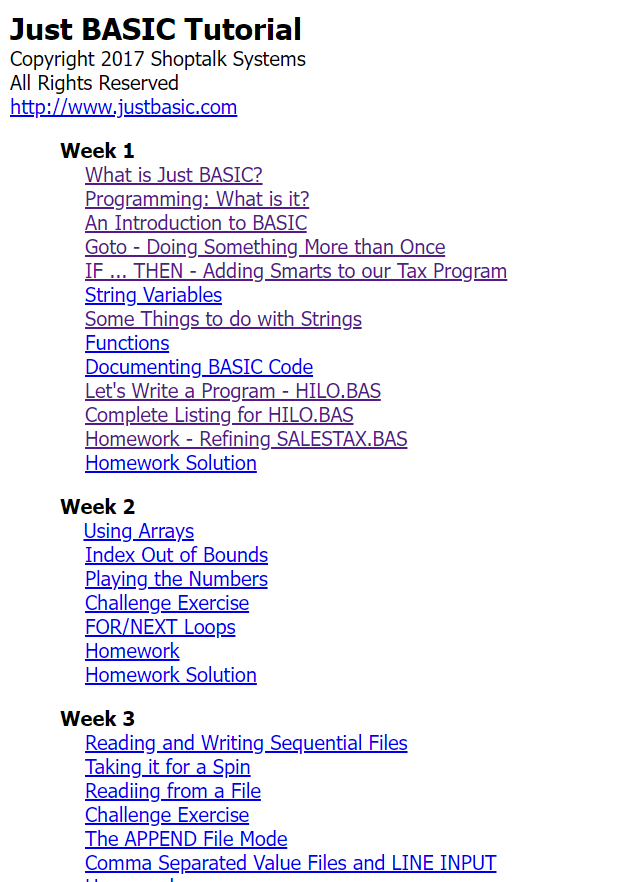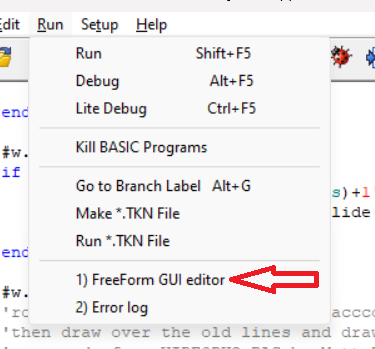Just BASIC is a freeware product providing a programming language and IDE for building Windows programs. It’s developed by Shoptalk Systems. It’s the first programming language I learned, back around 2011. I found it in a Google Search ad. Before that, I had no idea what programming was, let alone did I consider it a career choice. As far as I was concerned, I was going to become an astronomer. It comes with a tutorial that I went through–I was more patient with tutorials back then. The first time that I felt the rush of getting a program to work was when I wrote my first Hello World ever in Just BASIC. Well, I think that happened–it was a long time ago. The first game that I wrote is the high-or-low game from the language’s tutorial.
Recently, I decided to revisit Just BASIC to see how it’s changed, and because I felt nostalgia for my early programming days. Afterwards, I was left with questions about how Just BASIC influences me as a programmer today. The experience also reminded me that software rots: my old BASIC code and Just BASIC’s first major version still worked on my machine, but I won’t always be so lucky.
Just BASIC is still actively developed. In fact, version 2.0 was released in November 2022. As a child, I used version 1, but I haven’t kept up with updates to Just BASIC since I was a teenager.
Since I didn’t have copies of the BASIC programs I wrote a decade ago readily available, I looked up example Just BASIC code on GitHub. Then, I installed Just BASIC on to an external drive and fired it up. Upon starting Just BASIC, I’m greeted with a dialog that links to some resources, including the tutorial.

The UI looks very recognizable. Clicking on “Tutorial,” which is a separate document from “Help,” takes me to a local web page that used to be a Windows .hlp file. The Windows Help format (WinHlp32) is a way of packaging documentation for Windows programs that isn’t supported by modern Windows versions. Based on the Just BASIC help page titled “Help Files are Converted to HTML,” I think the documentation was converted to HTML when Windows Vista still had some support from Microsoft.

I remembered one of the first pages of the tutorial asking me to enter print
"Hello World!" as my first program, but I don’t see that at the beginning of
the tutorial. So, I downloaded Just BASIC v1.01, which I learned is still hosted
on the Just BASIC
website1 after finding
the filename of the installer on
software.informer, a
website that I’ve never heard of. (To be clear, if you want version 1, I
recommend downloading it from the Just BASIC website.) Then I viewed the version
1 tutorial using a copy of
WinHlp32.exe,
and that tutorial doesn’t start with a Hello World either. Turns out the “Hello
World!” program is on the “Writing your own Programs” page of the version 1.01
Help document, so my memory was wrong. Nevertheless, it’s nice to see what I’m
pretty sure is my first program again.
Returning to the version 2 tutorial, part of the it that I recognize is the
high-or-low game in HILO.BAS. It looks like the language hasn’t changed much
syntactically. You even still have to append a dollar sign to ends of names of
string-typed variables! (See the Variables chapter in Help.)
My general impression of both versions of the tutorial is that they seem to be geared towards business use cases. I think the version 2 tutorial might be more business-oriented than in version 1, but I haven’t looked at the version 1 tutorial for more than a decade.
Just BASIC comes with a form designer written in Just BASIC. You can access the designer through the Run menu with the “FreeForm GUI editor” option.

The GUI editor looks like how I remember it: an inner window with a toolbox on the left, all in an older Windows style. I don’t remember what the tool icons mean, and I doubt I ever understood all of them. Since there are no tooltips either, I started clicking on the tools that piqued my interest. The first two buttons are for loading and saving form designs, respectively.

The two buttons in the second row from the bottom export whatever form you’ve designed in the GUI as code. I’m not sure what the difference between them is.

New Features
One new feature in Just BASIC 2 is highlighting of variable uses. Much like in other IDEs, you can select a variable, and the other places where the variable occurs will be highlighted. Another new feature is that you can Ctrl-Click on a label to navigate to where the label is declared. These features are described in a page called “Variable highlighting and click-navigation in code editor” in the documentation.
Additionally, the “Memory limit raised from 70MB to 256MB” page tells us that the memory limit for the IDE and programs running in it together was raised to 256 MB from 70 MB. The limit exists for the sake of garbage collection performance. I didn’t even know there was a limit, let alone such a low one. I guess I never ran into it.
Just BASIC in Action
Let’s run a program I found online. This one’s called “When Chickens Attack!!!,” and it’s creator is Bennett Cyphers. You can find it on GitHub. It seems to work without modification, so I suppose Shoptalk Systems maintained some level compatibility between versions 1 and 2.
As I look at the code, there are some oddities about the language that I didn’t notice before. I didn’t notice these when I first used the language, since it is my first language, but some parts of Just BASIC syntax are different from every other programming language I’ve used. I suppose some of these idiosyncrasies are normal compared to Just BASIC’s related BASIC dialects.
The first thing I noticed is that a Just BASIC program communicates with windows and controls by printing messages to them. Indeed, you give the control name as a target to the print statement along with a string containing a command to send to the control. For example, here’s a program that creates a graphics window titled “Hello World!” and fills it with yellow:
open "Hello World!" for graphics as #g
print #g, "fill yellow"
wait
In this example, I print the message “fill yellow” to the window #g to fill it with yellow.
To create controls, there are commands for each kind of control you can create.
For example, the textbox keyword is used to create a textbox in a window, as
in textbox #windowname.textboxname, 10, 30, 100, 20. Those numbers at the end
are the x and y coordinates of the textbox and its width and height,
respectively. There’s no other programming language I’ve used where the way to
create GUI controls is through particular syntax allocated to those controls.
Another thing is that there are three ways to define procedures. There are
“functions” which are different from “subroutines” and that have a different
call syntax. The third way is to define a label, and then use the gosub
statement to jump to that label. Version 1 of the tutorial doesn’t seem to teach
you explicitly how to define your own functions and subroutines, but I see uses
of gosub in the tutorial’s homework solutions. That would explain why I
remember using gosub and labels, but not the function nor the subroutine
syntax. Oddly, the version 2 tutorial doesn’t introduce function or subroutine
definitions either.
Personal Archeology
While writing this post, I remembered that I once printed out the source of a BASIC program during middle school, and that my parents might be able to find it in their house. Which they did! Turns out preserving your own code is useful. They found two versions, text-mode and GUI, of a program that distributes days among months in a hypothetical calendar given the length of the year, the length of the day, the number of months in a year, and the days per week. If I remember correctly, the goal of the program is to generate imaginary calendars for various planets. Here’s a scan of the code with output for an Earth-like calendar, which is hopefully in order, and here’s the code for a GUI version of the program. Amazingly, this code also runs in Just BASIC v2 depsite being writen for version 1. It has a few bugs, though.
A funny thing about my code is that I use a string as an array of words. I think I did that because the language lacks dynamically-sized arrays. (According to the “Arrays” page in Help, arrays cannot be resized without clearing them of data.) The trick of using a string as an array is well-known in the Just BASIC forum (this link goes to a page that might require completing a CAPTCHA), so I think I got the idea from the forum.
Takeaways
When I started writing this post, I wanted to satiate my nostalgia for the programming experience I had as a child that I found in Just BASIC. I succeeded, I think. I encourage you to also go back to your early programming environments to relive some of the joy of learning how to code. Or maybe your early experiences with programming were negative, in which case, you can remind yourself of what you overcame.
Additionally, you can consider is how your earliest programming environment influences you as a programmer today. For example, I wonder which of my current habits can be seen in my calendar code, how Just BASIC influenced my syntax preferences and attitude towards static typing, and how the language drove my programming interests. I won’t address those questions here, but they’re interesting questions.
Another benefit of returning to your first programming language is that you can engage in a bit of personal software preservation. I managed to find a copy of Just BASIC v1 despite it not being officially listed on its website, which means everyone can still see what it was like. That said, version 2 is seems to be largely compatible with it, so maybe that’s not as important. More important to me is being able to save some of my earliest code, not just to learn from it, but as a keepsake.
Conclusion
It turns out that Just BASIC hasn’t changed all that much, and that it still has an active community. It’s nice to see that sort of stability and longevity. Let’s hope that it’ll last another decade, and for even longer–and that the world never loses access to this fun piece of software.